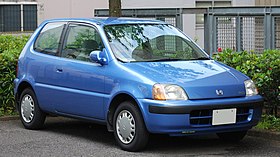| Honda Logo (GA3/5) | |
|---|---|
 Honda Logo (pre-facelift) | |
| Overview | |
| Manufacturer | Honda |
| Production | 1996–2001 |
| Assembly | Japan: Suzuka, Mie |
| Body and chassis | |
| Class | Supermini |
| Body style | 3- and 5-door hatchback |
| Layout | Front-engine, front-wheel-drive Front engine, four-wheel-drive |
| Related | Honda HR-V Honda Capa Honda EV Plus |
| Powertrain | |
| Engine | 1.3 L D13B I4 SOHC (early version 8 valves, 16 valves later version) |
| Transmission | 3-speed automatic 5-speed manual CVT |
| Dimensions | |
| Wheelbase | 2,360 mm (92.9 in) |
| Length | 3,785 mm (149.0 in) |
| Width | 1,645 mm (64.8 in) |
| Height | 1,525 mm (60.0 in) |
| Curb weight | 890 kg (1,962.1 lb) |
| Chronology | |
| Predecessor | Honda City (series GA1-GA2) |
| Successor | Honda Fit |
The Honda Logo is a B-segment supermini manufactured and marketed by Honda from 1996 to 2001, as a three-door and five door hatchback, sharing its platform with the Honda Capa and replacing the second generation Honda City. The Logo was larger than the kei class Honda Life, smaller than the subcompact Honda Civic, and was superseded by the Honda Fit.
It was marketed in Japan through dealerships of Honda Clio from 1996 to 2001, and briefly in the United Kingdom between 2000 and 2001. The Logo was an effort by Honda to repeat the success of early Civic, with its length, width, and engine size almost matching the first generation Civic.[1]




